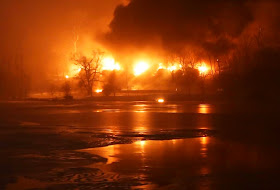FEBRUARY 19, 2015
WASHINGTON, DC
Federal investigators will examine whether pressurized gas
played a role in the massive blast that followed the derailment of a train carrying
crude oil through West Virginia this week, the U.S. Transportation Department
said on Thursday.
Questioning the possible role of gas vapors in the West
Virginia fire broadens the debate over how to ensure public safety at a time
when drastically larger volumes of crude oil are being shipped by rail and roll
through cities and towns.
At least two dozen oil tankers jumped a CSX Corp. track
about 30 miles south of the state capital, Charleston, on Monday, touching off
a fireball that sent flames hundreds of feet into the sky.
The U.S. Transportation Department said it has an
investigator at the site to take samples of crude once the wreckage stops
burning.
“We will measure vapor pressure in the tank cars that
derailed in West Virginia,” department spokeswoman Suzanne Emmerling said.
Some experts say the nature of the explosion, which saw a
dense cloud of smoke and flame soaring upwards, could be explained by the
presence of highly pressurized gas trapped in crude oil moving in the rail
cars.
“Vapor pressure could be a factor,” said Andre Lemieux of
the Canadian Crude Quality Technical Association, a trade group that is
helping the Canadian government adopt crude oil quality tests.
The American Petroleum Institute, the leading voice for the oil
industry, declined to comment on whether high vapor pressure might have played
a role in West Virginia.
“What we need to do now is allow the accident investigators
to do their jobs,” said Brian Straessle, a spokesman for the trade group.
In the past twelve months, API and the North Dakota
Petroleum Council have argued the dangers of vapor pressure are exaggerated,
citing self-funded studies that indicate vapor pressure readings are safe.
Starting in April, North Dakota oil producers will have to
tame vapor pressure dangers as part of a statewide plan to reduce dangers on
the tracks.
But there is no national standard to control the risk of
dangerous gas in oil train cargo.
The Transportation Department declined to govern vapor
pressure in a national oil train safety plan conceived last summer. That plan
is now with the White House for final review.
The proposal would have oil trains fitted with advanced
braking systems to prevent pileups and tougher shells akin to those carrying
volatile propane gas on the tracks.
The question of whether gas vapors make oil shipments more
prone to detonate has been kept on the margins of the U.S. debate over
transporting oil by rail.
The oil train sector has thrived in recent years, pushed by
a crude oil renaissance in North Dakota’s Bakken region.
Of the roughly 1.2 million barrels of crude oil produced in
North Dakota daily, more than 60 percent of that fuel reaches refineries by
rail, typically in 100-tanker unit trains that can stretch a mile long.
Rail and tank car industry leaders have warned that Bakken
fuel is uncommonly volatile and that toughened rail cars are needed to control
the risk of explosion.
Moving Bakken crude in containers akin to those that haul
propane gas on the tracks, as the DOT has outlined, would be one way to
mitigate dangers and “the likelihood of seeing… mushroom clouds going up into
the sky,” Bob Fronczak, the Association of American Railroad’s hazmat chief,
told a safety hearing in April 2014.
Fronczak declined to comment on Thursday. An AAR spokesman
said the trade group backed a strong oil train safety plan and looked forward
to seeing a final proposal due in May.
Tougher cars and advanced brakes will likely mitigate future
oil train mishaps but investigators are right to scrutinize every risk that
could have contributed to the West Virginia mishap, said Cynthia Quarterman who
recently resigned as head of the DOT’s Pipeline and Hazardous Materials Safety
Administration.
“Any hazmat regulator or investigator worth his salt would
gather as much data as possible,” she said.
BLEVE could also cause the explosions. Under this theory, when a fire burns outside
the tank car, heats up the car further volatilizing the crude oil. This build up of vapors inside the tank car
will lead into its gigantic explosion, as we witnessed at so many other tank
car explosions like this one.
We also believe that ice on the lines could also cause the
derailment of these cars, as it has happened at other occasions and documented
by the Canadian TSB. Other factors may
well be the lack of maintenance of the tracks, human error, speed around bents,
and so on.
With so many factors that can cause derailment and
subsequent fire and explosions, we believe that it is extraordinarily reckless
to continue to allow 3,000,000 gallons of crude of oil to be transported in
this fashion. We need to force these
companies to limit the number of tank cars allowed to be transported, to have
independent third party audit of the rail tracks, and so on. Otherwise, we are playing Russian roulette
with the properties, livelihood of other people for the sake of crude oil and
other hazardous material.







